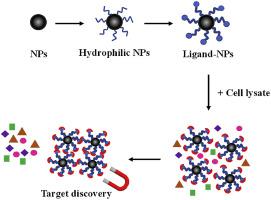Journal of Pharmaceutical Analysis ( IF 8.8 ) Pub Date : 2020-02-05 , DOI: 10.1016/j.jpha.2020.02.002 Dandan Xia , Baoling Liu , Xiaowei Xu , Ya Ding , Qiuling Zheng

|
Drug target discovery is the basis of drug screening. It elucidates the cause of disease and the mechanism of drug action, which is the essential of drug innovation. Target discovery performed in biological systems is complicated as proteins are in low abundance and endogenous compounds may interfere with drug binding. Therefore, methods to track drug-target interactions in biological matrices are urgently required. In this work, a Fe3O4 nanoparticle-based approach was developed for drug-target screening in biofluids. A known ligand-protein complex was selected as a principle-to-proof example to validate the feasibility. After incubation in cell lysates, ligand-modified Fe3O4 nanoparticles bound to the target protein and formed complexes that were separated from the lysates by a magnet for further analysis. The large surface-to-volume ratio of the nanoparticles provides more active sites for the modification of chemical drugs. It enhances the opportunity for ligand-protein interactions, which is beneficial for capturing target proteins, especially for those with low abundance. Additionally, a one-step magnetic separation simplifies the pre-processing of ligand-protein complexes, so it effectively reduces the endogenous interference. Therefore, the present nanoparticle-based approach has the potential to be used for drug target screening in biological systems.
中文翻译:

磁性纳米粒子偶联质谱法发现药物靶标
药物靶点发现是药物筛选的基础。它阐明了疾病的原因和药物作用的机制,这是药物创新的基本要素。在生物系统中执行的目标发现非常复杂,因为蛋白质含量低且内源性化合物可能会干扰药物结合。因此,迫切需要在生物基质中追踪药物-靶标相互作用的方法。在这项工作中,开发了一种基于Fe 3 O 4纳米粒子的方法来筛选生物流体中的药物靶标。选择了已知的配体-蛋白质复合物作为验证原理的实例,以验证可行性。在细胞裂解液中孵育后,配体修饰的Fe 3 O 4纳米颗粒与靶蛋白结合并形成复合物,然后用磁铁将其与裂解物分离,以进行进一步分析。纳米颗粒的大的表面体积比提供了更多的化学药物修饰的活性位点。它增加了配体-蛋白质相互作用的机会,这对于捕获目标蛋白质(特别是对于那些低丰度的蛋白质)是有益的。此外,一步磁分离简化了配体-蛋白质复合物的预处理,因此有效地减少了内源性干扰。因此,本基于纳米颗粒的方法具有用于生物系统中药物靶标筛选的潜力。



























 京公网安备 11010802027423号
京公网安备 11010802027423号